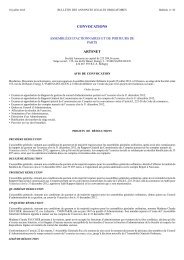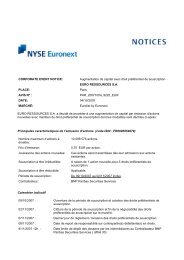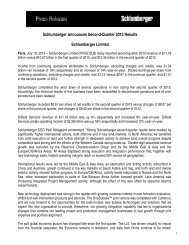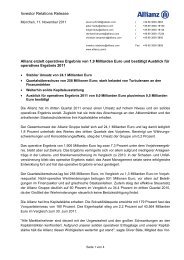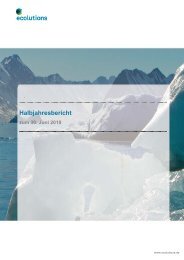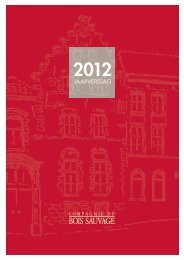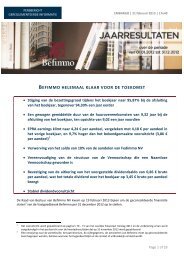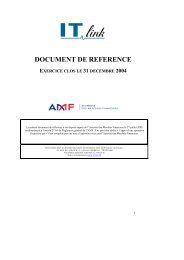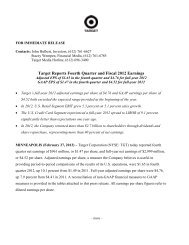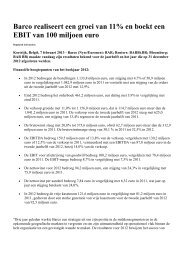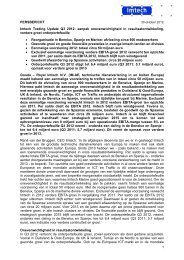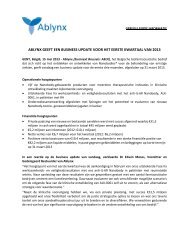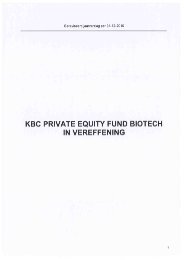Download full Annual Report and Accounts - Kingfisher
Download full Annual Report and Accounts - Kingfisher
Download full Annual Report and Accounts - Kingfisher
Create successful ePaper yourself
Turn your PDF publications into a flip-book with our unique Google optimized e-Paper software.
Kingfi sher plc<br />
<strong>Annual</strong> <strong>Report</strong><br />
<strong>and</strong> <strong>Accounts</strong><br />
2009/10<br />
Accountability, risk management <strong>and</strong> internal control<br />
The Board considers risk assessment, identifi cation of mitigating actions<br />
<strong>and</strong> internal control to be fundamental to achieving the Company’s<br />
strategic corporate objectives. This system of internal control is:<br />
– the Board’s overall responsibility;<br />
– annually reviewed for its effectiveness by both the Board <strong>and</strong><br />
the Audit Committee; <strong>and</strong><br />
– in compliance with the Turnbull Guidance 2005.<br />
However, such a system is designed to manage rather than eliminate<br />
the risk of failure to achieve business objectives <strong>and</strong> can provide only<br />
reasonable <strong>and</strong> not absolute assurance against material misstatement<br />
or loss.<br />
The Board has approved a set of policies, procedures <strong>and</strong> frameworks<br />
for effective internal control that implement the Turnbull Guidance,<br />
‘Internal Control: Revised Guidance for Directors on the Combined<br />
Code’, for the year under review <strong>and</strong> to the date of approval of this<br />
<strong>Annual</strong> <strong>Report</strong>. These procedures are subject to regular review <strong>and</strong><br />
provide an ongoing process for identifying, evaluating <strong>and</strong> managing<br />
the signifi cant risks faced by the Group.<br />
The internal audit function:<br />
– works with the operating companies to develop, improve <strong>and</strong> embed<br />
risk management tools <strong>and</strong> processes into their business operations;<br />
– oversees the operation of the individual operating businesses’ audit<br />
committees;<br />
– ensures that business risks are identifi ed, managed <strong>and</strong> regularly<br />
reviewed by management at all levels of the Group <strong>and</strong> that directors<br />
are periodically appraised of the key risks in accordance with the<br />
Turnbull Guidance 2005;<br />
– provides the Audit Committee <strong>and</strong> the Board with objective<br />
assurance on the control environment across the Group; <strong>and</strong><br />
– monitors adherence to the Group’s key policies <strong>and</strong> principles.<br />
Management at each operating company has responsibility for the<br />
identifi cation <strong>and</strong> evaluation of the signifi cant risks applicable to their<br />
business <strong>and</strong> any mitigating actions to be taken through the Retail<br />
Board, which reviews, identifi es <strong>and</strong> evaluates the risks that are<br />
signifi cant at a Group level as well as the mitigating actions against<br />
those risks. These are then considered by the Board. The type of risks<br />
identifi ed include strategic risk, external factors (such as competition,<br />
environment <strong>and</strong> regulation), change management programmes, health<br />
<strong>and</strong> safety, retention of key management <strong>and</strong> macro market risks.<br />
39<br />
Monitoring <strong>and</strong> review activities<br />
There are clear processes for monitoring the system of internal control<br />
<strong>and</strong> reporting any signifi cant control failings or weaknesses together<br />
with details of corrective action. These include:<br />
– a formal quarterly confi rmation provided by the fi nance director<br />
of each operating company certifying the operation of their control<br />
systems <strong>and</strong> highlighting any weaknesses, the results of which<br />
are reviewed by regional management, the Audit Committee <strong>and</strong><br />
the Board; <strong>and</strong><br />
– periodic examination of business processes on a risk basis including<br />
reports on controls throughout the Group undertaken by the internal<br />
audit function which reports directly to the Audit Committee.<br />
Any controls <strong>and</strong> procedures, no matter how well-designed <strong>and</strong><br />
operated, can provide only reasonable <strong>and</strong> not absolute assurance<br />
of achieving the desired control objectives. Management is required<br />
to apply judgement in evaluating the risks facing the Group in achieving<br />
its objectives, in determining the risks that are considered acceptable<br />
to bear, in assessing the likelihood of the risks concerned materialising,<br />
in identifying the Company’s ability to reduce the incidence <strong>and</strong> impact<br />
on the business of risks that do materialise <strong>and</strong> in ensuring the costs<br />
of operating particular controls are proportionate to the benefi t.<br />
The Board confi rms that it has reviewed the effectiveness of the internal<br />
control system, including fi nancial, operational <strong>and</strong> compliance controls<br />
<strong>and</strong> risk management in accordance with the Combined Code for the<br />
period from 1 February 2009 to the date of approval of this <strong>Annual</strong><br />
<strong>Report</strong>. Following this review, the Board is satisfi ed that the system<br />
of internal control is effective.



